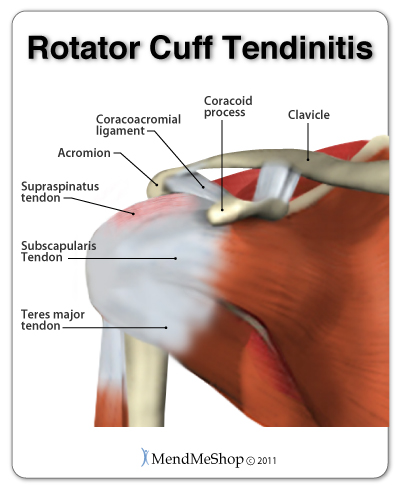
I would like to go out on a limb here (no pun intended) and say that the shoulder is the doozie of all tendonitis’. This would be my professional opinion as it is one of the most common impairments I come across on a daily basis. There are many different stages of irritation to the shoulder, that categorize as “non traumatic” (this means no specific mechanism of injury, fall, car accident or specific date of injury) I will further discuss how it starts, how it changes, worsens and can become one of the most dreaded injuries to the body….the rotator cuff tear. So, being this one of my favorite problems to treat, here goes the most simplistic explanation of how it starts, how it worsens and WHY it is so important to treat EARLY on.
The rotator cuff is comprised of 4 muscles that “cup” onto the humeral head (the upper circular part of the arm bone). These muscles #1 job is to stabilize the humeral head and help guide it with any movement of the arm that is away from the body. If these muscles are weak or tight the mechanics of this complex joint begin to fail. Increased friction of surfaces thus begins. This is where tendonitis tends to begin. Either the suprapinatus muscle/tendon unit (the #1 most torn tendon of the rotator cuff) or the tendon of the biceps will begin to become irritated because of their location. Other structures can become inflamed (bursa, infraspinatus tendon) that aid in the inflammation of the shoulder. Furthermore, painful overhead movement, reaching out in front of self or carrying, lifting objects that are painful only continue to AGGRAVATE the shoulder. More than 2 weeks of shoulder pain is a RED FLAG to get immediate attention.
Tendonitis will worsen because the body tries to guard itself from pain by accommodation and compensation. We begin to take ibuprofen/ motrin, etc. and begin to do our daily activities, our sport, our workouts, our jobs differently (from a mechanical perspective) in order to stay away from pain. This worsens and aggravates the shoulder in the long run. The body lays down scar tissue in order to help heal and protect. Scar tissue is extra tissue that many times can aid in further irritation. The shoulder complex gets weaker and tissue becomes more inflamed and irritated with everyday that passes by.
Eventually the tendon can become so frayed (think of a frayed rope) that the tissue becomes weak and can eventually break (tear). This is where the term rotator cuff tear comes from. Rotator cuff tears are painful, debilitating and can mean surgery a lot of the time. In order to prevent this from happening a specific plan needs to be implemented in your life. Shoulder tendonitis is treated differently depending on what stage of injury you are in, your activity demands and the goals that you have as a person.
Don’t be a victim to surgery that is not necessary. Rotator cuff tears that emanate from chronic shoulder tendonitis are preventable and repairable most of the time. Be patient and give the program some time to work. Remember…we use our shoulder for just about everything…..turning our alarm clock off, making meals, driving, brushing our teeth, answering our phones, folding laundry, putting our clothes on….the list is endless. Take care of it and it will take care of you!

